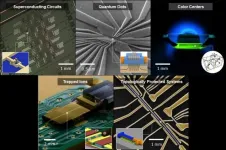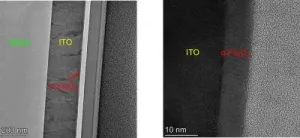(Press-News.org) A new study outlines the need for materials advances in the hardware that goes into making quantum computers if these futuristic devices are to surpass the abilities of the computers we use today.
The study, published in the journal Science by an international team, surveyed the state of research on quantum computing hardware with the goal of illustrating the challenges and opportunities facing scientists and engineers.
While conventional computers encode "bits" of information as ones and zeroes, quantum computers breeze past this binary arrangement by creating "qubits," which can be complex, continuous quantities. Storing and manipulating information in this exotic form - and ultimately reaching "quantum advantage" where quantum computers do things that conventional computers cannot - requires sophisticated control of the underlying materials.
"There has been an explosion in developing quantum technologies over the last 20 years," said Nathalie de Leon, assistant professor of electrical and computer engineering at Princeton University and the lead author of the paper, "culminating in current efforts to show quantum advantage for a variety of tasks, from computing and simulation to networking and sensing."
Until recently, most of this work has aimed to demonstrate proof-of-principle quantum devices and processors, de Leon said, but now the field is poised to address real-world challenges.
"Just as classical computing hardware became an enormous field in materials science and engineering in the last century, I think the quantum technologies field is now ripe for a new approach, where materials scientists, chemists, device engineers and other scientists and engineers can productively bring their expertise to bear on the problem."
The paper is a call to scientists who study materials to turn to the challenge of developing hardware for quantum computing, said Hanhee Paik, corresponding author and a research staff member at IBM Quantum.
"The progress in quantum computing technologies has been accelerating in recent years both in research and industry," Paik said. "To continue moving forward in the next decade, we will need advances in materials and fabrication technologies for quantum computing hardware -- in a similar way to how classical computing progressed in microprocessor scaling. Breakthroughs do not happen overnight, and we hope more people in the materials community will begin to work on quantum computing technology. Our paper was written to give the materials community a comprehensive overview of where we are in materials development in quantum computing with expert opinions from the field."
At the heart of quantum computers are qubits, which work together to churn out results.
These qubits can be made in various ways, with the leading technologies being superconducting qubits, qubits made from trapping ions with light, qubits made from the silicon materials found in today's computers, qubits captured in "color centers" in high-purity diamonds, and topologically protected qubits represented in exotic subatomic particles. The paper analyzed the chief technological challenges associated with each of these materials and proposes strategies for tackling these problems.
Researchers hope that one or more of these platforms will eventually progress to the stage where quantum computing can solve problems that today's machines find impossible, such as modeling the behaviors of molecules and providing secure electronic encryption.
"I think [this paper] is the first time that this kind of comprehensive picture has been assembled. We prioritized 'showing our work,' and explaining the reasoning behind the received wisdom for each hardware platform," de Leon said. "Our hope is that this approach will make it possible for new entrants to the field to find ways to make a big contribution."
The ten co-authors come from research institutions around the world as well as IBM T. J. Watson Research Center, which has a major quantum computing research group. The scientists met during a symposium on materials for quantum computing sponsored by IBM Quantum and the Kavli Foundation and held at the Materials Research Society Fall Meeting in 2019. They then spent much of their time during the pandemic's stay-at-home period last year developing this review paper.
"It was a great experience to work with a group with such diverse expertise, and a lot of our activity involved asking each other tough questions about why we believed the things we did about our respective material platforms," said de Leon, whose research exploits flaws in diamond materials to enable communication between nodes in a future quantum internet.
INFORMATION:
De Leon leads the materials thrust of the new Co-Design Center for Quantum Advantage (C2QA), in which Princeton plays a major role. Funded by the U.S. Department of Energy, the center aims to develop quantum information systems and the quantum workforce that will be needed to design and build these machines.
Support for this project comes from the National Science Foundation (NSF), the Army Research Laboratory's Center for Distributed Quantum Information, the Horizon 2020 Framework Programme Quantum Internet Alliance, the Austrian Science Fund, the Samsung Science and Technology Foundation, the National Research Foundation of Korea, the Creative Pioneering Researchers Program through Seoul National University, the Institute for Quantum Matter under DOE Energy Frontier Research Center, the QNEXT DOE National Quantum Information Science Research Centers, the NSF-sponsored Penn State Two-Dimensional Crystal Consortium-Materials Innovation Platform, the Program Management Unit for Human Resources Institutional Development Research and Innovation, and an ETH Zürich postdoctoral fellowship.
JACKSONVILLE, Fla. -- In a new paper published in Nature Communications, Mayo Clinic researchers and collaborators report the protein-coding gene SERPINA5 may worsen tau protein tangles, which are characteristic of Alzheimer's disease, and advance disease. By combining clinical expertise, brain tissue samples, pathology expertise and artificial intelligence, the team clarified and validated the relevance of the gene to Alzheimer's disease.
The researchers used tissue samples from 385 brains donated to the Mayo Clinic Brain Bank, which houses more than 9,000 brain tissue specimens for the study of neurodegenerative disorders. The samples were from people who were diagnosed with Alzheimer's disease and lacked co-existing diseases found in ...
Hydrogen will be needed in large quantities as an energy carrier and raw material in the energy system of the future. To achieve this, however, hydrogen must be produced in a climate-neutral way, for example through so-called photoelectrolysis, by using sunlight to split water into hydrogen and oxygen. As photoelectrodes, semiconducting materials are needed that convert sunlight into electricity and remain stable in water. Metal oxides are among the best candidates for stable and inexpensive photoelectrodes. Some of these metal oxides also have catalytically active surfaces that accelerate the formation of hydrogen at the cathode or oxygen at the anode.
Why is rust not much better?
Research has long focused on haematite (α-Fe2O3), ...
MINNEAPOLIS - April 19, 2021 - Despite access to some of the best possible medical care in the world, Senators John McCain and Edward Kennedy both died within 18 months of their diagnosis of glioblastoma, an aggressive form of brain cancer. While this deadly outcome typifies the nature of this disease, some glioblastoma patients see exceptional benefits from chemotherapy and survive beyond expectations. Why this happens has been revealed by researchers at the University of Minnesota in a new study published in the Proceedings of the National Academy of Sciences.
"Deciphering the molecular underpinning of these exceptional ...
In March 2020, when the pandemic hit, everything slowed, including non-essential medical procedures such as elective surgeries, to reduce the spread of the coronavirus.
Six weeks later, Mary Byrnes, Ph.D., an assistant research scientist in the Department of Surgery at Michigan Medicine, began calling University of Michigan Frankel Cardiovascular Center patients whose surgeries had been canceled or delayed. She wanted to hear about their experiences -- what undergoing surgery meant to them, how postponing their operations had affected them, whether the existence of the coronavirus complicated how they felt about their bodies and ...
Psoriasis is a common inflammatory skin condition. The underlying genetic factors have not yet been sufficiently researched. The skin inflammation is usually triggered by external factors such as infections or stress. A research team at the Institute of Cancer Research of the Medical University of Vienna has now managed to identify a new factor in signal transmission of the immune system that plays a major role in the development of a psoriatic episode. The scientists have shown that symptoms can be alleviated by inhibiting the "c-Jun" protein in signal transmission.
The common clinical manifestation of psoriasis is a pinkish-grey thickening of the epidermis in distinct foci of infection, ...
It has been known for about a year that minks can become infected with SARS-CoV-2. The virus had been transmitted from humans to farmed mink and mutated in infected animals. Mutations were acquired in the spike protein, which is crucial for the entry of the virus into host cells and represents the central point of attack for antibodies. These SARS-CoV-2 variants from mink were transmitted back to humans, raising concerns that minks could be a continuing source of infection of humans with SARS-CoV-2 variants with altered biological properties. Researchers at the German Primate Center (DPZ) - Leibniz Institute for Primate Research in Göttingen, Germany, have now shown that an antibody used for COVID-19 ...
A simple dietary supplement reduces behavioral symptoms in mice with a genetic mutation that causes schizophrenia. After additional experiments, including visualizing the fluorescently stained dancing edge of immature brain cells, researchers concluded that the supplement likely protects proteins that build neurons' cellular skeletons.
The supplement betaine was first isolated from sugar beets and is often associated with sweetness or umami flavor. Healthy levels of betaine come from both external food sources and internal synthesis in the body. Betaine ...
Up to 25 percent of global food production is lost annually due to insects, primarily beetles. For the past 500 million years, beetles have successfully spread and adapted to life around the globe and now account for one of every five animal species on Earth. Yet as far back as ancient Egypt, these tough little bugs have invaded granaries and vexed us humans by destroying our crops.
As a result, food production and an abundant use of pesticides now go hand in hand. A large share of these pesticides damage biodiversity, the environment and human health. As various pesticides are phased out, new solutions are required to target and eradicate pests without harming humans or beneficial ...
Atlantic bluefin tuna have returned to UK waters and can once again be seen during the summer and autumn months.
Their numbers appear to be increasing, following a long period of absence linked to population decline, according to research led by Cefas and the University of Exeter.
Marine scientists in the UK and Ireland have analysed multiple datasets, spanning a 16-year period, to document the increase in bluefin, which arrive into the waters of the Celtic Seas and off South West England, the Scilly Isles, and North West Ireland to feed in late summer and autumn.
The research is part of the Defra-funded "Thunnus UK" research project. ...
Stroke risk for patients with traumatic brain injuries is at its highest in the four months following injury and remains significant for up to five years post-injury, finds a new systematic review led by a team at the University of Birmingham.
Traumatic brain injury (TBI) is a global health problem affecting over 60 million people a year worldwide. Incidences of TBI are rising due to a range of factors including increased falls in the elderly, military conflict, sports injuries and road traffic accidents. However, advances in critical care and imaging have led to a reduction in TBI-related mortality.
Previous studies have associated TBI with a long-term risk of neurological diseases including dementia, ...



